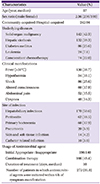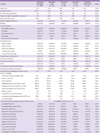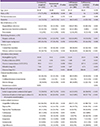1. Tsai MS, Kuo CY, Wang MC, Wu HC, Chien CC, Liu JW. Clinical features and risk factors for mortality in Aeromonas bacteremic adults with hematologic malignancies. J Microbiol Immunol Infect. 2006; 39:150–154.
2. Wu CJ, Wu JJ, Yan JJ, Lee HC, Lee NY, Chang CM, Shih HI, Wu HM, Wang LR, Ko WC. Clinical significance and distribution of putative virulence markers of 116 consecutive clinical
Aeromonas isolates in southern Taiwan. J Infect. 2007; 54:151–158.

3. Lee WS, Puthucheary SD. Retrospective study of Aeromonas infection in a Malaysian urban area: a 10-year experience. Singapore Med J. 2001; 42:57–60.
4. Mandell GL, Bennett JE, Dolin R, editors. Mandell, Douglas and Bettett's Principles and practice of infectious diseases. 6th ed. Philadelphia: Elsevier Churchill Livingstone;2005.
5. Llopis F, Grau I, Tubau F, Cisnal M, Pallares R. Epidemiological and clinical characteristics of bacteraemia caused by
Aeromonas spp. as compared with
Escherichia coli and
Pseudomonas aeruginosa
. Scand J Infect Dis. 2004; 36:335–341.

6. Ko WC, Wu HM, Chang TC, Yan JJ, Wu JJ. Inducible beta-lactam resistance in
Aeromonas hydrophila: therapeutic challenge for antimicrobial therapy. J Clin Microbiol. 1998; 36:3188–3192.

7. Ko WC, Lee HC, Chuang YC, Liu CC, Wu JJ. Clinical features and therapeutic implications of 104 episodes of monomicrobial
Aeromonas bacteraemia. J Infect. 2000; 40:267–273.

8. Choi JP, Lee SO, Kwon HH, Kwak YG, Choi SH, Lim SK, Kim MN, Jeong JY, Choi SH, Woo JH, Kim YS. Clinical significance of spontaneous
Aeromonas bacterial peritonitis in cirrhotic patients: a matched case-control study. Clin Infect Dis. 2008; 47:66–72.

9. Rhee JY, Kwon KT, Ki HK, Shin SY, Jung DS, Chung DR, Ha BC, Peck KR, Song JH. Scoring systems for prediction of mortality in patients with intensive care unit-acquired sepsis: a comparison of the Pitt bacteremia score and the acute physiology and chronic health evaluation II scoring systems. Shock. 2009; 31:146–150.

10. Clinical and Laboratory StandardsInstitute (CLSI). Performance Standards for Antimicrobial Susceptibility Testing: Fifteenth informational supplement. Wayne, PA: CLSI;2005. p. M100-S11.
11. Campo C, Navarro V, Pérez C, Gutiérrez I, Alonso R.
Aeromonas spp bacteremia: study of 12 cases and review of the literature. Enferm Infecc Microbiol Clin. 2001; 19:161–164.
12. Ko WC, Chuang YC.
Aeromonas bacteremia: review of 59 episodes. Clin Infect Dis. 1995; 20:1298–1304.
13. Lai CC, Shiao CC, Lu GD, Ding LW.
Aeromonas hydrophila and
Aeromonas sobria bacteremia: rare pathogens of infection in a burn patient. Burns. 2007; 33:255–257.

14. Lau SM, Peng MY, Chang FY. Outcomes of Aeromonas bacteremia in patients with different types of underlying disease. J Microbiol Immunol Infect. 2000; 33:241–247.
15. Doudier B, Imbert G, Vitton V, Kahn M, La Scola B.
Aeromonas septicaemia: an uncommon complication following placement of transhepatic biliary drainage devices in Europe. J Hosp Infect. 2006; 62:115–116.

16. Huang LJ, Chen HP, Chen TL, Siu LK, Fung CP, Lee FY, Liu CY. Secondary
Aeromonas peritonitis is associated with polymicrobial ascites culture and absence of liver cirrhosis compared to primary
Aeromonas peritonitis. APMIS. 2006; 114:772–778.

17. Sebo P, Sakbani K, Rohner P, Gavazzi G.
Aeromonas bacteremia in an elderly immunocompetent patient. Aging Clin Exp Res. 2006; 18:344–346.

18. Sánchez-Céspedes J, Figueras MJ, Aspiroz C, Aldea MJ, Toledo M, Alperí A, Marco F, Vila J. Development of imipenem resistance in an
Aeromonas veronii biovar sobria clinical isolate recovered from a patient with cholangitis. J Med Microbiol. 2009; 58:451–455.

19. García-Irure JJ, Navascués A, Vivanco M, Rodrígo A. Spontaneous bacterial peritonitis and bacteraemia due to Aeromonas hydrophila
. An Sist Sanit Navar. 2003; 26:429–431.
20. Funada H, Matsuda T.
Aeromonas bacteremia in patients with hematologic diseases. Intern Med. 1997; 36:171–174.
21. Harris RL, Fainstein V, Elting L, Hopfer RL, Bodey GP. Bacteremia caused by Aeromonas species in hospitalized cancer patients. Rev Infect Dis. 1985; 7:314–321.
22. Kimura M, Araoka H, Yoneyama A.
Aeromoans caviae is the most frequent pathogen among cases of
Aeromonas bacteremia in Japan. Scand J Infect Dis. 2013; 45:304–309.

23. Kao HT, Huang YC, Lin TY. Fatal bacteremic pneumonia caused by Aeromonas hydrophila in a previously healthy child. J Microbiol Immunol Infect. 2003; 36:209–211.
24. Tang HJ, Lai CC, Lin HL, Chao CM. Clinical manifestations of bacteremia caused by Aeromonas species in southern Taiwan. PLoS One. 2014; 9:e91642.
25. Tena D, González-Praetorius A, Gimeno C, Pérez-Pomata MT, Bisquert J. Extraintestinal infection due to Aeromonas spp.: review of 38 cases. Enferm Infecc Microbiol Clin. 2007; 25:235–241.
26. Kim J, Lee Y, Park Y, Kim M, Choi JY, Yong D, Jeong SH, Lee K. Anaerobic bacteremia: impact of inappropriate therapy on mortality. Infect Chemother. 2016; 48:91–98.









 PDF
PDF ePub
ePub Citation
Citation Print
Print




 XML Download
XML Download